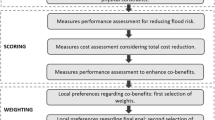Abstract
Based on the regional cooperation policy outlined in the National Land Plan of Japan, this study developed a regional cooperation planning model (RCPM) for use by regional planners and researchers. RCPM includes two sub-models. The first sub-model is the local service evaluation model (LSEM), which employs grey multiple criteria evaluation to assess local services for individual cities, towns and villages. The second sub-model is the cooperative partner assignment model (CPAM), which applies grey multiple objective 0–1 programming to determine optimal cooperative partners for individual cities, towns and villages. Applying RCPM to eastern Taiwan yielded the following conclusions. First, the current division of Living Perimeters in the Eastern Taiwan Region should be adjusted according to the analytical results presented in this study to reach further benefits of cooperation. Second, since RCPM uses grey numbers to display input data and research findings, it provides planning flexibility and resolves uncertainties in practical planning. Finally, the modeling results contribute to cooperative strategy development among neighboring areas in an underdeveloped region.
Similar content being viewed by others
References
Blume L, Blume T (2007) The economic effects of local authority mergers: empirical evidence for German city regions. Ann Reg Sci 41: 689–713
Bock S (2006) City 2030: 21 cities in quest of the future: new forms of urban and regional governance. Eur Plan Stud 14(3): 321–334
Brenner N (2002) Decoding the newest metropolitan regionalism in the USA: a critical overview. Cities 19(1): 3–21
Deng JL (1982) Control problems of grey systems. Syst Control Lett 1: 288–294
Feng S, Xu LD (1999) Decision support for fuzzy comprehensive evaluation of urban development. Fuzzy Sets Syst 105: 1–12
Foo TS (2000) Subjective assessment of urban quality of life in Singapore (1997–1998). Habitat Int 24(1): 31–49
Haughwout AF (1999) Regional fiscal cooperation in metropolitan areas: an exploration. J Policy Anal Manag 18(4): 579–600
Hauswirth I (2003) Incentives and disincentives to city-regional cooperation in the Berlin-Brandenburg conurbation. Eur Urban Reg Stud 10(2): 119–134
Huang G, Moore D (1993) Grey linear programming, its solving approach, and its application. Int J Syst Sci 24(1): 159–172
Hwang CL, Yoon K (1981) Multiple attribute decision making: methods and applications. Springer, Berlin
Kashiwadani M, Asakura Y, Uno M (1999) Road network improvement and regional cooperation effects. J East Asia Soc Transp Stud 3(4): 237–251
Knapp W, Kunzmann KR, Schmitt P (2004) A cooperative spatial future for RheinRuhr. Eur Plan Stud 12(3): 323–349
Lai YJ, Liu TY, Hwang CL (1994) TOPSIS for MODM. Eur J Oper Res 76(3): 486–500
Lin JJ, Feng CM, Ting PY (2005) The regional cooperation model for science parks planning. J Taiwan Land Res 8(1): 41–69 (in Chinese)
National Land Agency (1997) Regional cooperation corridor: definitions, evaluation, strategies and transportation infrastructures. Gi-yo-ro-se-i Ltd, Tokyo (in Japanese)
Rogerson RJ, Findlay AM, Morris AS (1989) Indicators of quality of life: some methodological issues. Environ Plan A 21: 1655–1666
Turok I, Bailey N (2004) The theory of polynuclear urban regions and its application to central Scotland. Eur Plan Stud 12(3): 371–389
Wong C (2001) The relationship between quality of life and local economic development: an empirical study of local authority areas in England. Cities 18(1): 25–32
Yuan W, James P (2002) Evolution of the Shanghai city region 1978–1998: an analysis of indicators. J Environ Manag 64: 299–309
Zadeh LA (1963) Optimality and nonscalar-valued performance criteria. IEEE Trans Autom Control 8(1): 59–60
Author information
Authors and Affiliations
Corresponding author
Rights and permissions
About this article
Cite this article
Lin, JJ., Liu, YH. Developing regional cooperation strategies by multi-criteria decision making approaches. Ann Reg Sci 49, 191–211 (2012). https://doi.org/10.1007/s00168-011-0436-6
Received:
Accepted:
Published:
Issue Date:
DOI: https://doi.org/10.1007/s00168-011-0436-6




